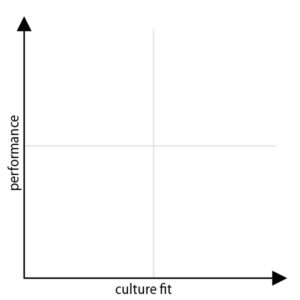At least once a year, every company should take stock of every employee and where they stand in terms of performance and culture fit within the organization.
Here’s what you need to do: Take a sheet of paper and divide it into four quadrants. Then label the vertical axis performance and the horizontal one culture. Performance gets better as it goes up, culture as it goes right.

Then plot each employee into one of those quadrants based on their performance and how well they fit with your company culture.
To some managers and business owners, this exercise seems pretty harsh, but it’s an effective decision-making tactic precisely because it helps you remove your emotions from the equation. And in the long run, it will make your organization better.
Bottom left: low performance, low culture
In the bottom left you have the people who are low performers and who don’t really fit with the company culture. They’re not really working and contributing to the bottom line, and they’re often troublemakers from a culture perspective.
People in this quadrant don’t typically move to another quadrant, regardless of how hard you try. You need an exit strategy for these employees. You need to be documenting policy violations and implementing a performance improvement plan so you have the right things in place when it comes time to terminate these employees.
Bottom right: low performance, high culture
This quadrant gets interesting. These people embody the values of the company and they fit in really well. We like them, and we want them to stay around, but they’re not producing the value that we need.
If you’re dealing with employees in this box, the chief task you have before you is helping them move into that top right corner so that they can contribute even more. Is it education they need? Motivation? Discipline? A different position within your company that better leverages their skills? Whatever it is, find out and invest in that employee to try to move them to the upper right quadrant.
Top right: high performance, high culture
These are your best employees, the ones that you want to hold on to for the long term. When you find people who fit in this box, you work hard to retain them, while continuing to invest in other employees to help them move into this box.
Think about your retention strategy with these employees. Are you asking the right questions? Are salaries competitive? Stay interviews can be a valuable tool to help understand these employees and focus on retention. Make sure you’re paying these people what they’re worth and showing them the appreciation they deserve.
You don’t want to handcuff yourself to these employees and ignore everyone else, but you do want to make sure you’re aware of these employees and rewarding their contributions.
Top left: high performance, low culture
These employees are the test of your organization. They’re great at making money—often this category includes some of the “rainmakers” of the organization. But at the same time, they’re absolute poison for company culture. Nobody wants to work with them, but companies make excuses and keep these toxic employees around because of the revenue they produce.
With these employees, you need to think about what they bring in compared to the collateral damage they cause. Toxic employees cause good employees to leave, and we’ve seen it sink companies again and again. If you continually ignore the bad behavior of an employee, eventually it becomes part of your culture that you can do anything you want as long as you bring in revenue.
Many managers are scared to discipline these high-performing employees, but it’s necessary if you want to avoid destroying your culture. Don’t compromise your company values and damage your culture by making excuses for high-performing but low-culture employees.
If you’re struggling with making decisions about culture versus performance in your company, take some time to do this exercise. It will help you make the decisions you need to make and create a better, safer, more harmonious work environment.
Need help completing this activity? Contact Why HR today for more information about our services. We also have a presentation as part of our Let’s Talk series on Facing Your Fears About Employee Discipline. It’s a great session for new and experienced managers who need a confidence boost for dealing with challenging employees.
